copy for test
How Technology Changes Society
(Go to the Online Lessons Home page to access a PDF version.)
Introduction Video | Dr. Lori Lopez | 1:14 mins
Introduction video: click to launch or to access from PDF version, copy and paste this URL into your browser: https://mediaspace.wisc.edu/media/Week+2+-+How+Technology+Changes+Society/0_jxkqz17k
Key Questions
- What is technological determinism and how is this way of thinking expressed?
- Who is Marshall McLuhan and how did he understand technology?
- How did the development of media technologies change society?
- How can media impact the relationship between time and space?
Understanding Technological Determinism
Technological determinism is the idea that technology is the primary driver of our society—technology is what causes cultural and social change, and it shapes human existence. It’s the idea that technology is what determines the way that our society develops, and that technology is more significant than other factors.
In today’s lesson we’re going to spend some time looking at the history of media technologies. Under the perspective of technological determinism, the development of these technologies would be seen to have a profound effect on society. We might even go so far as to think that developments in technology have been the primary driving force influencing the entire course of human history.
Where do we see evidence of this perspective?
2001: A Space Odyssey – the Dawn of Man | 9.33 mins (clip)
Watch this scene from the famed Stanley Kubrick film 2001: A Space Odyssey and think about what message is being conveyed about the relationship between man and technology.
2001: A Space Odyssey clip: click to launch or to access from PDF version, copy and paste this URL into your browser: https://youtu.be/ypEaGQb6dJk
We see the monkeys first as animals, very primitive in the way that they relate to one another and their surroundings. They resolve conflict through testing their physical strength against one another. Then we see the unexplained arrival of something much more technologically advanced than them, a mysterious structure that they reach out to interact with. In the very next scene, the monkey looks at the pile of bones and starts to have a new realization–the bones can be useful to him. He bangs them on the ground and realizes that they enhance his physical strength, perhaps enough for him to physically overpower another creature. The next time that a conflict arises within the group, he uses this newfound technology to assert his dominance. In discovering the tool, he is set upon the journey toward progress and change–and eventually, the evolution from primitive animal into human.
Technology as Defining Quality
This basic sense that humans evolve based on their relation to the development of technologies can be seen in the way that we classify periods in human history. Titles such as “The Stone Age” and “The Bronze Age” clearly emphasize the role of technology in shaping how we think about our own history.
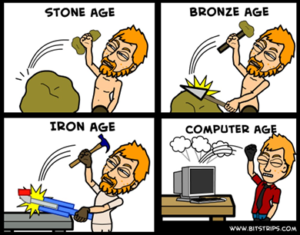
Another indicator of how prominently we consider technology can be seen in how closely we connect national identities to technology. Think about the technologies that are associated with certain nations—Japan and robots, Germany and cars, Holland and windmills. This kind of thinking is infused into many different aspects of how we view human history and culture.
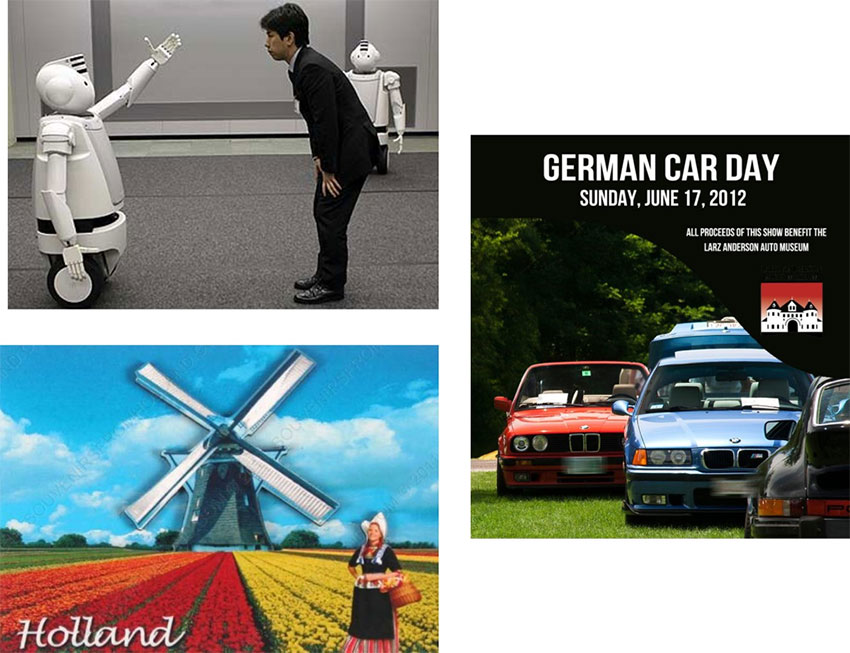
Marshall McLuhan
“The medium is the message.”
This focus on the centrality of media technologies can clearly be seen in the work of Marshall McLuhan, a public intellectual from Canada who rose to prominence in the 1950s. His work has been connected to ideas of technological determinism, particularly with his famous notion that “The medium is the message.”
Watch this clip of McLuhan speaking in a televised interview, and listen to how he describes this idea. What does he mean when he says the medium is the message?
The Medium is the Message – Marshall McLuhan | First 8 mins (clip)
McLuhan video: click to launch or to access from PDF version, copy and paste this URL into your browser:
https://mediaspace.wisc.edu/media/Marshall+Mcluhan+Full+lecture-+The+medium+is+the+message+-+1977+part+1+v+3/0_4whgw2r6/32607362
Let’s dig deeper into McLuhan’s theories to understand how he came to this understanding of media.
First, McLuhan argues that all media entail mediation. This is the idea that the content of any medium is just another medium. For instance, the content of television is moving images and sound; the content of the newspaper is articles or perhaps images; the content of a newspaper article is speech; and the content of speech is thought. This is why he comes to believe that content is not what is most important, because content can be traced further and further back until it is simply the thoughts in your head.
So if content is not important, what is important? McLuhan wants us to be careful not to get blinded by content, or overly fixate on content, but to be aware of how media themselves are shaping our world.
“The personal and social consequences of any medium result from the new scale that is introduced into our affairs by each extension of ourselves, or by any new technology.”
As he says in the clip, his belief is that it doesn’t matter what you say on the phone, the important thing is that telephone technology is shaping society. The important fact is that everyone has access to telephones and is using them. Similarly, it doesn’t matter what kids are reading, the important thing is that they grow to value literacy and stories and education, that they’re able to use literacy to accomplish things. Or even bigger, the important thing is the impact that literacy has had on society, and how society was shaped by the advent and spread of literacy. The same is true with television—it’s not what is on television that matters, it’s the entire technology of television as something different from a radio or a movie that has changed society. We can start to see that he is fairly critical of television in this clip, but we can also understand that his bigger point is that having television as a widespread media technology has clearly impacted all of our lives.
McLuhan calls media extensions of man because they extend our senses. They allow us to see and hear and touch things that we otherwise wouldn’t have access to. Telephones extend our voice and spreads it influence, movies extend our eyes and ears, the computer extends our brain. If media are seen to be metaphorically part of our bodies and central nervous systems, part of who we are and how we operate in the world, we can see how he thinks it’s so important. He believes media and society are closely connected, so we always need to think big picture about the effect that it has on society and human functions.
So when McLuhan says that “The medium is the message,” he means that “the message” is the social impact that a technology has, the way it changes the course of human life. It’s the medium that changes the way we think, and what is possible. It makes it possible for us to think and to do new things, and that’s what we need to pay attention to.
Selected History of Media
To further understand how prevalent discourses of technological determinism are, let’s look at a select history of media technologies. This lesson is obviously very limited, because there are many different histories that together tell the story of how our media ecology evolved. But we can point to a few select advances in media technology and discuss what they mean. These will include:
- Literacy
- Photography
Literacy
Although today we take literacy and our written culture somewhat for granted, writing itself is a technology that needed to be developed over the course of human society. Earliest human societies were oral, relying on spoken language to convey messages and maintain relations over time. Epics like Beowulf, or Homer’s The Iliad and The Odyssey were all transmitted orally from generation to generation.

In the pre-class reading, Levinson describes the special quality of oral communication, where “what is spoken and heard, but unseen, acquires larger-than-life qualities in the re-telling” (p. 25). We can think about what these stories would have meant to us if they were only heard, and we never had the chance to read them or see images of them. But then this kind of experience shifted with the advent of technologies such as the alphabet and the manuscript.
What we think of as “the book” was adopted around 400 AD, but this technology could have developed differently. Before the book, words were recorded on technologies such as long scrolls of continuous print, and hammered tablets. But the technology that stuck was the codex book, which consists of a series of pages bound together at the spine. To access content, readers flip through its pages.

The question we want to think about is, how does the ability to write things down impact society? How does society change because of this technological advancement? Writing was actually met with skepticism when it was introduced, because changing from an oral culture to a written culture was such a huge change. This reminds us that all technological change is difficult and part of a long process because it has such a big impact on society.
Impacts of Literacy on Society:
- Writing distances the speaker from the listener. While oral cultures relied on forging connections with your fellow man, and trusting their expertise, writing distances the speaker from the listener. You no longer need face-to-face contact to spread information. This distance can also entail distrust, or misinformation.
- The development of “virtual” communication, where the speaker didn’t need to be present. Documents become the repository for information, rather than people. Written words can disseminate information without needing to rely on person-to-person contact.
- Writing allows for built-upon knowledge. Knowledge is no longer something that is internal to individuals; people can use the information from multiple sources to increase knowledge.
- Training and education become more important and “knowledge classes” become more prominent. This allows for the introduction of concepts such as linear time and recordable histories.
When McLuhan says “the medium is the message,” he means that all of these changes are the most important thing. The social impact of the technology of literacy is “the message.”
Monopolies of Knowledge
Some of the impact of literacy that extends to all new technologies comes from what Harold Innis calls monopolies of knowledge. This concept refers to the situation when the ruling class possesses communication technologies and keeps them from the masses. They hoard and protect access to technology so they can be the only ones to benefit from it.
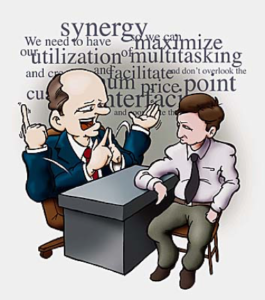
One example of this might be the professional jargon that doctors and lawyers use so that everyday citizens can’t understand them. On one hand it might be funny how difficult it is to understand what these professionals are saying, but more importantly, it means that regular people can’t diagnose their own illnesses or represent themselves within the legal system. They have to pay doctors and lawyers to do give them access to information.
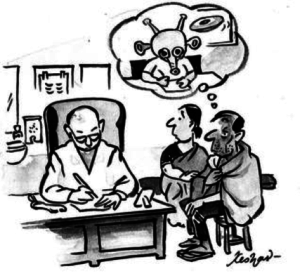
To bring this back to our discussion of literacy—at its most basic level, literacy is a technology that was kept from the masses. When print was first developed, scribes were the only ones who knew how to read and write, so they wielded enormous power in society. At various times in history there has been an effort to make sure everyone can read and has access to information, and then there have been times when access to information has been severely limited. We can see this even today—in certain countries, portions of the internet are censored and made inaccessible, while in others the internet is seen as something that must be opened up to everyone equally. So as with all media technologies, it’s important to always ask who benefits and who is held back by access and knowledge.
The printing press is another important technological advance. In 600 A.D. we saw the invention of the Chinese printing press, where books were being printed with woodblock prints. Around 1045, movable type was invented—though, because the Chinese written language consists of over 10,000 characters, it didn’t really catch on. In the 1450s, Johannes Gutenberg invented his printing press, with the 26 letters of the alphabet in metal on wooden frames. They were covered with an oil-based ink and then pressed onto paper with a large hand-cranked press. By 1500, printing presses and mass-produced books were commonplace. In fact, over 20 million books had been printed before 1500.
More Monopolies of Knowledge
Another example of a monopoly of knowledge in the early era of writing was that priests and religious leaders were the first to learn how to read and write, and that training was kept for only them.This made it of course difficult to challenge the power of the church, because normal people didn’t have access to sacred writings. Before the print era, The Roman Catholic Church in particular was enormously powerful and controlled the majority of wealth across Europe. It had a significant influence over society and commerce, largely because it had control over written texts as well as visual arts.
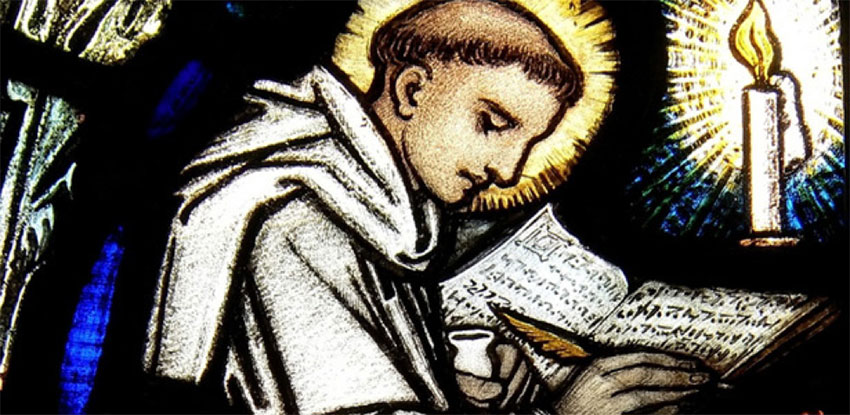
But then Martin Luther came along and was a leader of the protestant reformation in the 1500s. One of his central ideas was that people should be able to read the Bible themselves, not requiring church officials to read it to them. He translated the Bible into vernacular German instead of Latin in order to make it accessible to the people. One of the first things that Gutenberg published with his printing press was the Bible, and it was said to have started the Gutenberg Revolution. So the Protestant Reformation coincided with the availability of Bibles and the ability of ordinary people to read them and develop their own relationship to their faith that wasn’t mediated through clergy and the church. This was a huge blow to the power of the churches, who could no longer control knowledge—and as a result, lost some of their political power as well.
Public Education
With the accessibility of printed materials, it becomes important to teach common people how to read. The level of literacy among all social classes grew exponentially, creating a literate culture. Farmers could keep track of weather, merchants could keep track of purchases and sales, citizens could write contracts with their fellow citizens.
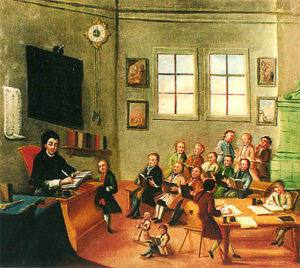
Literacy training and a more literate population also contributed to the rise of science and the scientific method. This is the notion that ideas should be tested and those tests should be recorded, rather than just trusting a smart person who claims something. Scientists could convey to each other how they had been testing ideas, and then once those ideas are proven accurate, they could be disseminated to the public and recorded for history. Even after the scientists and authors had died, their ideas could live on.
Literacy and access to printed works also help to create an informed electorate. The press could convey ideas about the state and how it was being run, and citizens could form opinions about what was going on. They didn’t just have to blindly trust what their leaders told them in public gatherings.
Effects of Print Technologies
- Mass communication is born
- Democratization of knowledge—normal people can have access to books and other texts. Normal people can also write their own books and spread that information to the masses.
- Development of journalism and advertising. Not necessarily the birth of advertising, newspapers started to provide a reliable new way of conveying ads to the masses
- Rise of public education
- Science flourishes
- Knowledge becomes more of a commodity. Also there is a shift in how we view knowledge; it’s not just something the elites possess and maintain, it’s something that someone can put into a book and then sell for money
- Prices increase for producers and decreases for consumer—more people can buy books and newspapers and pamphlets
Photography
Photography emerged in the 1830s with the daguerreotype—let’s watch a brief video describing the process of developing a daguerreotype.
The Daguerreotype – Photographic Processes | 6:32 mins
Daguerreotype Process video: click to launch or to access from PDF version, copy and paste this URL into your browser:
https://mediaspace.wisc.edu/media/The+Daguerreotype-+Photographic+Processes/0_m7pnyy4i/32607362
After this photographic process was invented, there were many more advances that followed. Photographers were able to reduce the time of exposure, take pictures on film, print pictures on paper, and other improvements. But the idea of seeing the very first photographic image is still a profound one—it’s a practice that changes forever how you see yourself, how you see history, how you see the world.
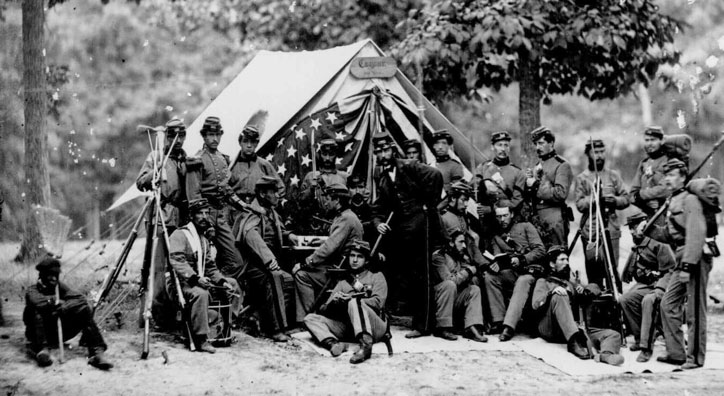
One of the first important uses of photography in 1837 was that it allowed journalists to share images of the Civil War. Photographers were embedded in the front lines to document the carnage and help to communicate the terrible human cost of the war. They helped to shape the way that the pubic viewed war, since people who were nowhere near the battlefields could see how dangerous and awful it was.

As cameras got smaller and lighter and processes for developing got safer, photography continued to spread. Photojournalists in the 1930s captured the tragedy of the Great Depression, taking pictures of families and their situations, of the Dust Bowl and its destruction. This generated support for President Roosevelt and his New Deal policies. Photos had the ability to tell stories without words and share them with wide audiences. Photographs were thought to accurately mirror the world and show that it could be known and understood.
Effects of Photography
- Challenged the authority of the written and spoken word, as photos seemed more authoritative and objective than people or the writing of people. This was despite the fact that photographs have always been manipulated, staged, reshot, and edited during processing.
- Photographs were used as identifying documents to establish one’s identity, as evidence in court, and as illustrations of news and journalism.
- Photography provided a different way of recording history—a visual history. Beyond telling audiences a story, they could show the story in one singular frame. We understand images and read images in different ways than we do words, and this vocabulary needed to be developed.
This is only a selective history, and there are many other important landmarks in media development that each had profound impacts on society as they came about. But hopefully this brief narratives helps us to see common ways of understand these technological developments.
Time-Space Compression
What we are beginning to see is that one of the big changes media bring to society is the compression of time and space. Media actually change our relationship to time and space. Space is compressed because you can interact with someone thousands of miles away from your own home, from the comfort of your home. Time is compressed because you can access people, information, and ideas immediately, whether they are happening currently or happened years ago.
To see how revolutionary the compression of space and time is, we can look at the significance of transportation as a communication technology. The time for news to travel from New York City to Cincinnati, Ohio has drastically shortened over time.
- 44.5 days in 1794
- 19 days in 1817
- 7 days in 1841
What caused these changes? In 1794, information had to be transmitted using a man on horseback. Then in 1817, messages could be transmitted using a river steamboat, which was much faster. By 1841, messages could be transmitted on the railroad. All of these inventions served to quicken the pace of news. After the development of the railroads, the telegraph and the radio clearly transformed the speed of communication. But the reality is that communication channels have always relied on technologies, even when the channels were roads and rivers, rather than electric cables and airwaves.
Media as Travel
With the compression of space and time, there have been other impacts of media on our social realities.
“When we communicate through the telephone, radio, television, or computer, where we are physically no longer determines where and who we are socially.”
– Joshua Meyrowitz, No Sense of Place
Media is changing our perception of space and what space means. Instead of space meaning a physical space, it can mean something social. You can be in your living room, but take an online class and be “at school”; you can be on a bus, but be emailing your grandma all the way across the country; you can be in your college dorm, but part of a conversation with your family at home. Not only is physical movement unnecessary, but there aren’t physical thresholds to mark boundaries either. No walls, doors, guards, moats. Access is a function of technology, not physicality. As technology has changed, our social situations and social identities have changed too.
Another way of thinking about how this idea that technology has changed our interaction with space is the concept of mobile privatization. This is the idea that individuals are able to increase mobility even while they stay at home. The home becomes a space that is open to increasing social options—social media allows you to travel the world. When you watch tv, it’s a window on the world. Alternatively, you can connect to your feeling of “being at home” from anywhere, as long as you have technology.
In some ways media creates presence, because you can be all alone and feel connected to people. They can give you social support, friendship, information, and really feel like they are right there with you. This is how media creates presence. But we can think of the flip side too, where you literally are in the presence of physical bodies, and yet everyone is absent. Media can create boundaries where people become so immersed in their media worlds that they are actually absent even when they stand in close quarters with other human beings.
So those are some of the ways that we might say technologies themselves are fundamentally changing the shape of society and how we are living in it, but we also want to think about challenges to this way of thinking. This is what we’ll be doing in our next lesson.
Key Concepts
- Technological determinism
- Marshall McLuhan
- Media as mediation
- “The medium is the message”
- “Extensions of Man”
- Media’s inseparability from society
- Codex Book
- Effects of Literacy
- Effects of Print
- Effects of Photography
- Religion and print
- Martin Luther
- Monopolies of Knowledge
- Time-Space compression
- Media as Travel
- Mobile Privatization
- Mediated presence/ absence
